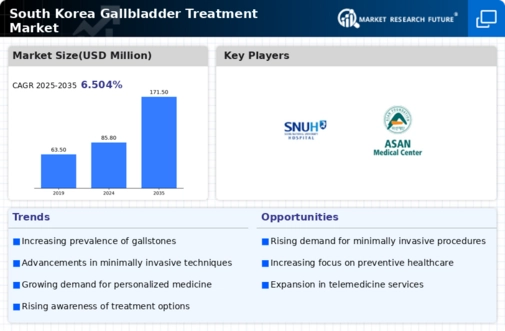Increased Healthcare Expenditure
The rise in healthcare expenditure in South Korea is a crucial factor influencing the gallbladder treatment market. As the government and private sectors allocate more funds towards healthcare services, patients gain better access to advanced treatment options. In 2025, healthcare spending in South Korea is projected to reach approximately 9.5% of GDP, reflecting a commitment to improving health outcomes. This increase in funding allows for the development of new treatment modalities and enhances the availability of existing ones. Consequently, patients are more likely to seek treatment for gallbladder disorders, thereby propelling the growth of the gallbladder treatment market. Enhanced insurance coverage and reimbursement policies further support this trend, making treatments more accessible to a broader population.
Advancements in Surgical Techniques
Innovations in surgical techniques, particularly minimally invasive procedures, are transforming the gallbladder treatment market. Techniques such as laparoscopic cholecystectomy have gained popularity due to their reduced recovery times and lower complication rates. In South Korea, the adoption of these advanced surgical methods has been on the rise, with hospitals increasingly investing in state-of-the-art equipment and training for healthcare professionals. This shift not only enhances patient outcomes but also drives market growth as more patients opt for these less invasive options. The gallbladder treatment market is likely to benefit from ongoing research and development in surgical technologies, which may lead to even more effective treatment solutions in the future.
Patient-Centric Healthcare Initiatives
The emphasis on patient-centric healthcare initiatives in South Korea is significantly impacting the gallbladder treatment market. Healthcare providers are increasingly focusing on personalized treatment plans that consider individual patient needs and preferences. This shift is supported by the integration of technology in healthcare, allowing for better patient engagement and education. As patients become more informed about their treatment options, they are more likely to seek timely interventions for gallbladder disorders. The gallbladder treatment market is expected to benefit from this trend, as healthcare systems prioritize patient satisfaction and outcomes. Furthermore, initiatives aimed at improving access to information and resources may lead to earlier diagnosis and treatment, ultimately enhancing the overall effectiveness of gallbladder care.
Rising Demand for Non-Surgical Treatments
The gallbladder treatment market is witnessing a notable shift towards non-surgical treatment options, driven by patient preferences and advancements in medical technology. Non-invasive procedures, such as endoscopic techniques and pharmacological therapies, are gaining traction as patients seek alternatives to traditional surgery. In South Korea, the increasing awareness of the risks associated with surgical interventions is prompting more individuals to consider these less invasive options. This trend is likely to expand the market for non-surgical treatments, as healthcare providers develop and promote effective alternatives. The gallbladder treatment market may see a diversification of treatment offerings, catering to the growing demand for safer and more patient-friendly solutions.
Growing Incidence of Gallbladder Disorders
The rising prevalence of gallbladder disorders in South Korea is a significant driver for the gallbladder treatment market. Factors such as dietary habits, obesity, and sedentary lifestyles contribute to an increase in conditions like gallstones and cholecystitis. Recent studies indicate that approximately 10-15% of the adult population in South Korea may experience gallstones at some point in their lives. This growing incidence necessitates effective treatment options, thereby expanding the market. As healthcare providers respond to this trend, the demand for both surgical and non-surgical treatment modalities is likely to increase, influencing the overall dynamics of the gallbladder treatment market. Furthermore, the aging population in South Korea is expected to exacerbate this issue, leading to a higher demand for gallbladder-related healthcare services.













Leave a Comment